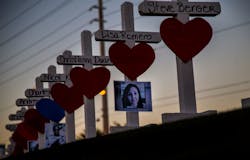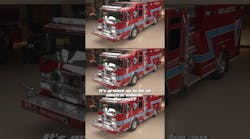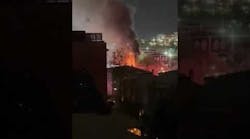Oct. 30--Clark County officials are looking to national authorities for guidance on how safety standards might be improved in light of the mass shooting Oct. 1 at the Route 91 Harvest Festival. And the two leading associations that craft the safety policies adopted by most municipalities across the country are looking right back at Las Vegas.
"I have no doubt there will be a review," said Fulton Cochran, assistant fire chief with the county's department of building and fire prevention, of how the International Code Council (ICC) and National Fire Prevention Association (NFPA) might modify recommendations after analysis of the incident.
ICC Senior Vice President of Technical Services Mike Pfeiffer says past tragedies have led to new safety code standards. Earlier mass shootings, for example, led the ICC to develop guidelines related to lockdowns. After 9/11, a code committee was formed to pinpoint lessons learned. Resulting changes are believed to have made public and private spaces safer, though most are far less visible to the average person than the measures seen at airports following the terrorist attack. But Pfeiffer cautions that the circumstances of the Las Vegas shooting make it unique, with gunfire coming from a hotel room more than 1,000 yards away.
- Berkowsky: Active Shooter Event Response
"I'm not sure you would address something like that in code," he said. "It is difficult to be responsive to any and all possible scenarios."
That said, he does see the potential for increased attention to evacuation procedures.
Crowd management and behavior could be studied, especially at the beginning of the 10-minute shooting ordeal. Videos from festivalgoers show performer Jason Aldean rushing off the stage and fans waiting in confusion, unaware that the pop-pop-pop in the background was active gunfire.
"Something like this is a wake-up call," Pfeiffer said.
The ICC publishes new standards called I-Codes every three years. The most recent set was sent to municipalities in mid-September for adoption at the local level sometime in 2018. That means the national organization just moved into a new cycle, which will culminate in the release of updated standards in 2020. It is accepting proposals for code revisions until January. After that, a multistep review process involving industry professionals, municipal officials and the general public will occur. It includes two physical public hearings where people can comment and an online public hearing process. (The general public also is welcome to submit proposals for revision of safety codes.)
- Siebert: Protecting the Protectors
Until the ICC sets new ones, Clark County's code officials plan to continue with current standards. Cochran doesn't expect any immediate changes in what safety inspectors consider during the permit-approval process, which right now is limited to technical aspects such as having compressed gas on site or the use of flame effects, and simply making sure the physical property matches the schematic submitted when an outdoor event received its special-use permit from the land use and planning department.
"We are processing additional events as they come in, but the rules haven't changed. We are actively looking at things and being very cautious in our reviews and approval, but we really like to have code behind us or an actual regulation," Cochran said of the fact that the county can change its protocols independently.
Meanwhile, the NFPA already was crafting new standards based on previous tragedies. In June, on the one-year anniversary of the Pulse Nightclub shooting that killed 49 people and wounded dozens more in Orlando, Fla., the NFPA announced the development of a guideline related to "preparedness and response to active shooter and/or hostile events." The goal is to create a standard for how emergency responders, hospitals, fire and local jurisdictional entities work together during an emergency.
The fire chief for Orange County, Fla., (where Orlando is located) proposed the new NFPA standard, hoping for a unified voice on the topic amid an increasing number of statements and recommendations from various entities at different governmental levels. During a public hearing, the proposal received the most comments and committee applications in the organization's 121-year history.
According to Ed Conlin, NFPA Public Fire Protection Division Manager, the committee hopes to finish the first draft of the guideline by December. Then, similar to the ICC cycle, it would be subject to a review process and could make its way to the municipal level in 2020.
Conlin wouldn't speculate as to how the Oct. 1 shooting might shape the work being done by its committee.
"Every incident, no matter where it occurs, the committee will look at," Conlin said.
Many municipalities, including Clark County, have emergency management plans in place to keep relevant bodies -- law enforcement, medical, etc. -- on the same page during a catastrophic event. Because of the high number of tourists and incidence of large crowds, the valley's municipal governments have long seen Las Vegas as a "soft target" vulnerable to a terrorist attack, and their entities have largely been praised for their coordinated efforts during and after Oct. 1.
Government officials and staffers aren't the only ones thinking about improved safety. Within the venue-management industry, conversations are ongoing about how to mitigate risk at events that bring in massive crowds.
Coordination with local law enforcement, and even state and federal agencies, already is standard, explained Mark Herrera, director of education at the International Association of Venue Managers (one of the largest associations for leaders of auditoriums, arenas and convention centers). But now there is movement toward involving nearby businesses or other entities that might have a stake during an emergency. For example, if an outdoor venue has tall buildings next to it that offer a vantage point for an elevated shooter -- as happened in the Las Vegas incident -- that venue might coordinate with event organizers.
"One of the things we're doing now is pushing out our buffer zones for what to include in the emergency planning process," said Herrera, adding that there is increased interest in crime prevention and safety through environmental design of spaces.
"The threat today is about ingress and egress," Herrera said. "So things like trying to reduce the queue time that you have to stand in line, or using signage so people attending know where the rally points are and where the evacuation points are."
___ (c)2017 the Las Vegas Sun (Las Vegas, Nev.) Visit the Las Vegas Sun (Las Vegas, Nev.) at www.lasvegassun.com Distributed by Tribune Content Agency, LLC.
Additional Resources for Active Shooter Response
- Berkowsky: Active Shooter Event Response
- La Mantia: MCI & MPI Preparations
- Perrigo: When Training Meets Reality: Orange County Active Shooter Training
- Vernon: Fire/EMS Response Considerations for Mass Shooting Incidents
- LeDuc: Planning for Your Active Shooter Response
- Mageria: The 'Omega Plan' for Firefighter Safety at Shooting Scenes
- Fire Chiefs Reflect on Pulse Nightclub Shooting
- Siebert: Protecting the Protectors
- Ludwig: EMS: The Active Shooter: Coming To a Community Near You?
- Ludwig: The Active Shooter: A Special Challenge
- Vernon: Fire and EMS Response to Mass Fatality Incidents
- Furey: Dispatch Protocols For Active-Shooter Incidents






